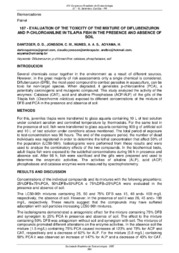Evaluation of the toxicity of the mixture of diflubenzuron and p-chloroaniline in tilapia fish in the presence and absence of soil.
Evaluation of the toxicity of the mixture of diflubenzuron and p-chloroaniline in tilapia fish in the presence and absence of soil.
Author(s): DANTZGER, D. D.; JONSSON, C. M.; NUNES, A. A. S.; AOYAMA, H.
Summary: aBSTRACT: Several chemicals occur together in the environment as a result of different sources. However, in the great majority of risk assessments only a single chemical is considered. Diflubenzuron (DFB), the most used compound to combat parasites in aquaculture, can be toxic for non-target species. When degraded, it generates p-chloroaniline (PCA), a potentially carcinogenic and mutagenic compound. This study analyzed the activity of the enzymes: Catalase (CAT), acid and alkaline Phosphatase (ACP/ALP) of the gills of the Tilapia fish (Oreochromis niloticus) exposed to different concentrations of the mixture of DFB and PCA in the presence and absence of soil.
Publication year: 2016
Types of publication: Abstract in annals or event proceedings
Unit: Embrapa Environment
Observation
Some of Embrapa's publications are published as ePub files. To read them, use or download one of the following free software options to your computer or mobile device. Android: Google Play Books; IOS: iBooks; Windows and Linux: Calibre.
Access other publications
Access the Agricultural Research Database (BDPA) to consult Embrapa's full library collection and records.
Visit Embrapa Bookstore to purchase books and other publications sold by Embrapa.

